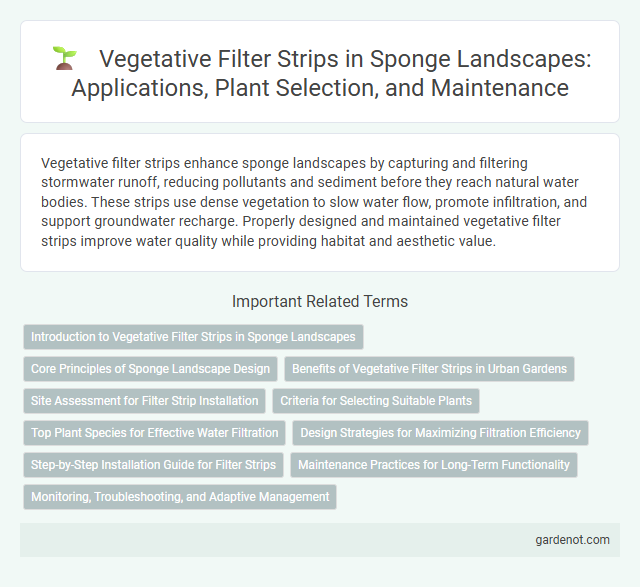Vegetative filter strips enhance sponge landscapes by capturing and filtering stormwater runoff, reducing pollutants and sediment before they reach natural water bodies. These strips use dense vegetation to slow water flow, promote infiltration, and support groundwater recharge. Properly designed and maintained vegetative filter strips improve water quality while providing habitat and aesthetic value.
Introduction to Vegetative Filter Strips in Sponge Landscapes
Vegetative filter strips in sponge landscapes serve as crucial bioengineering tools designed to intercept, absorb, and filter stormwater runoff through dense vegetation zones. These strips enhance water infiltration, trap sediments, and reduce nutrient loads, thereby improving water quality and mitigating flood risks. Integrating native plant species with deep root systems maximizes pollutant removal efficiency and supports ecological resilience within urban and peri-urban environments.
Core Principles of Sponge Landscape Design
Vegetative filter strips use dense vegetation to trap pollutants and enhance infiltration, reducing surface runoff and improving water quality. Key principles include selecting native plants with deep root systems to maximize soil stability and pollutant uptake. Designing appropriate strip width and slope ensures optimal sediment retention and effective water flow management within sponge landscapes.
Benefits of Vegetative Filter Strips in Urban Gardens
Vegetative filter strips in urban gardens enhance water quality by trapping sediments, nutrients, and pollutants before they reach waterways, reducing urban runoff contamination. These strips promote soil stabilization and prevent erosion, contributing to healthier plant growth and increased biodiversity. Their ability to support groundwater recharge and mitigate flooding makes them essential for sustainable urban landscape management.
Site Assessment for Filter Strip Installation
Site assessment for vegetative filter strip installation requires evaluating soil permeability, slope gradient, and existing vegetation to ensure effective water infiltration and pollutant removal. Identifying areas with moderate slopes (typically less than 15%) and well-drained soils enhances filter strip performance by preventing erosion and maximizing contaminant absorption. A thorough assessment also considers proximity to water bodies and land use patterns to optimize placement for stormwater runoff treatment.
Criteria for Selecting Suitable Plants
Selecting suitable plants for vegetative filter strips requires consideration of deep-rooted species to enhance soil stabilization and maximize pollutant filtration. Native plants with high water absorption capacity, drought tolerance, and rapid growth rates improve runoff interception and nutrient uptake efficiency. Diversity in plant species promotes resilience, supports local biodiversity, and optimizes the overall effectiveness of the sponge landscape system.
Top Plant Species for Effective Water Filtration
Vegetative filter strips rely on top plant species such as switchgrass (Panicum virgatum), big bluestem (Andropogon gerardii), and sedges (Carex spp.) for effective water filtration, enhancing sediment capture and nutrient uptake. These plants exhibit deep root systems and high biomass production, which improve soil infiltration rates and reduce surface runoff. Incorporating native species like wild rye (Elymus canadensis) further supports ecological balance while optimizing contaminant removal in sponge landscape designs.
Design Strategies for Maximizing Filtration Efficiency
Vegetative filter strips are optimized by incorporating dense, multi-species plantings with deep root systems to enhance sediment capture and nutrient uptake. Strategic placement on contour lines maximizes runoff retention time, allowing pollutants to settle before reaching water bodies. Integrating native grasses and shrubs increases soil permeability and microbial activity, significantly improving overall filtration efficiency in sponge landscape designs.
Step-by-Step Installation Guide for Filter Strips
A vegetative filter strip installation begins by selecting a suitable site with moderate slope and well-drained soil to maximize runoff filtration and sediment capture. Prepare the area by clearing debris, grading for uniform water flow, and enriching the soil with organic matter to support dense vegetation growth. Plant native grasses, shrubs, or other vegetation in rows perpendicular to water flow, ensuring adequate spacing and coverage to optimize pollutant removal and enhance water infiltration.
Maintenance Practices for Long-Term Functionality
Regular mowing and prompt removal of accumulated debris are essential maintenance practices to ensure the long-term functionality of vegetative filter strips in sponge landscapes. Periodic inspection for sediment buildup and erosion helps maintain their effectiveness in filtering runoff and promoting groundwater recharge. Implementing adaptive management, such as replanting native species and controlling invasive plants, supports sustained vegetation health and optimal water filtration.
Monitoring, Troubleshooting, and Adaptive Management
Monitoring vegetative filter strips involves regular assessment of plant health, soil infiltration rates, and pollutant removal efficiency to ensure optimal performance. Troubleshooting focuses on identifying and addressing issues such as soil compaction, nutrient imbalances, and vegetation stress that reduce filtration capacity. Adaptive management incorporates data-driven modifications to planting species, maintenance schedules, and design features to enhance stormwater treatment and landscape resilience.
Vegetative filter strip Infographic

 gardenot.com
gardenot.com